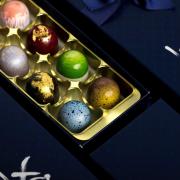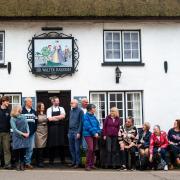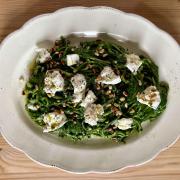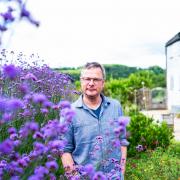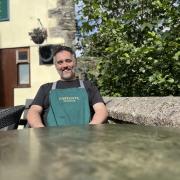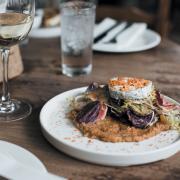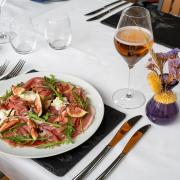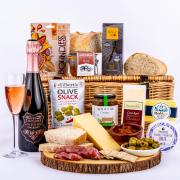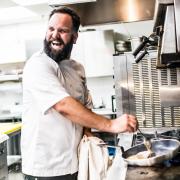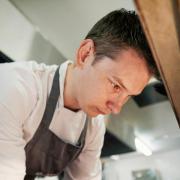Early summer brings colourful blooms and heady scents to gardens and hedgerows. Baker Sarah Raisbeck heads out into in the South Hams countryside to celebrate the season with a taster of floral foraged concoctions and a fruit and flower-laden cake
Spring and summer is the time of year when I truly feel so alive.
I was brought up in the countryside in a very wholesome and traditional way. Spring memories are all about the primroses, bluebells, wood anemones and the lime green colours of woodlands.
Picking flowers were, and still are, one of my most favourite things to do and summer’s warmer days means a garden full of flowers. Then there are the strawberries, blackcurrants and raspberries grown at the local pick-your-own. This brings back so many good memories, as children we would gorge ourselves and try to hide the evidence. Summer puddings were made with all the berries and fresh sponge cakes would be decorated with them. Pavlova was also a favourite to make for family and friend gatherings.

With each season I have my traditional foods I like to forage, and early summer brings the elderflower and roses.
I got married in the month of July and in early June we went on a big forage with friends to gather elderflowers which my sister Rach then made into elderflower champagne. It was transported from home in Hampshire down to Exmoor where we were to get married, but we discovered a day before the wedding that the champagne had turned!
Sadly, we didn’t have our elderflower for the wedding toast, but the memories have lasted, and I still fondly remember that June walk.

Elderflower Cordial recipe
A yearly ritual for my family for as long as I can remember is foraging elderflowers and making cordial to last the summer months.
After my experience of elderflower champagne, I feel cordial is the safer bet to make!
It's always good to pick the flowers in the sun when the perfume is at its best.
I have used this recipe year after year and it's based on one from Hugh Fearnley-Whittingstall's River Cottage.
Another very easy way to use this cordial is to mix with some fresh fruit and top with yoghurt, a very simple and delicious pudding.
Ingredients
25 flower heads
Zest and juice of 3 lemons and 1 orange
1kg raw cane sugar (or caster sugar)
Method
Pick the flowers off the stalks into a large bowl. Grate in the lemon and orange zest and pour over 1.5 litres of boiling water. Cover and leave to infuse overnight.
The next day drain the liquid through a sieve lined with a scalded jelly bag into a pan with the sugar and lemon and orange juice.
Heat gently until the sugar is dissolved, then boil for five minutes.
Make sure the bottles you are using are sterilised. Pour the cordial into the bottles and seal.
I like to store the bottles in the fridge to be sure they don’t spoil.

Rose Syrup recipe
This syrup can transform a freshly based cake, and I use it in a Victoria sponge. Spoon a few tablespoons over the freshly baked layers before sandwiching it together with cream.
Puddings like individual panna cottas also look very pretty with this syrup spooned over, as does a summer pavlova and ice cream.
Choose your roses carefully, making sure they are free of pesticides.
Ingredients
20 rose heads
1kg raw cane sugar (or caster sugar)
500ml filtered water
Method
Pick off all the petals putting them in a large pot for 90 minutes on a very low simmer. In this time the colour will drain from the petals, hopefully leaving you with a colourful liquid, depending on the roses used.
Drain, putting the strained liquid back in the pan with the sugar. Slowly heat, bringing to the boil until the sugar is completely dissolved.
Store in a jar in the fridge. Make sure the jar is sterilised, which will allow the syrup to last well in the fridge.

Summer Victoria sponge recipe
This sponge recipe comes from the brilliant Mary Berry, the queen of cake baking.
I like to fill my cake with freshly whipped double cream, with a layer of fruit jam in between and then top it with more cream and fresh, seasonal fruit and flowers.
I use all organic ingredients for my cakes.
Ingredients
4 eggs
225g unsalted butter, softened
225g raw cane sugar (or caster sugar)
225g self raising flour. (I like to also use heritage grain flours, but the sponge may not be so light then)
2tsp baking powder
6-8tbsp rose syrup (optional)
500ml double cream
Seasonal jam, half a jar
Fresh fruit
Method
Prepare the tin and preheat the oven to 175C /Gas 4.
Line two 7in spring-form tins with baking paper. I like to use slightly smaller tins to make sure I have a deeper sponge which makes it look more impressive.
Cream the butter and sugar together until pale. Then add the rest of the ingredients, starting slowly with the mixer, gradually speeding up to max until all the ingredients are really well mixed.
Divide the mix between the two tins, level the mix and place in the middle of the oven.
Put the timer on for 25 minutes, checking after 20 to turn around. Only remove from the oven once an inserted skewer comes out clean.
Leave the cake to cool then, once removed from the tins, spoon the syrup over the upturned halves.
Whip the cream until soft peaks form. I like to use a piping bag for presentation. Use a 1cm nozzle and pipe onto one half of the upturned cake. On the other side evenly spread the jam and then sandwich together.
Top with the rest of the cream and chosen fresh fruit and flowers.
Sarah Raisbeck trained as a chef at Tante Marie in Surrey and is the author of Natural Sweet Bakes.
Emma Stoner is a documentary and lifestyle photographer based in Totnes, Devon.




